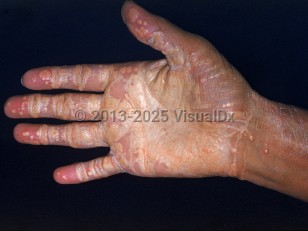The disease has autosomal recessive inheritance and is markedly increased in Japanese individuals, due to a founder mutation in that population, and in Sardinia. All races and ethnic groups are affected, and there is not a significant difference in incidence between sexes. The affected gene WRN is a helicase (RECQL2) involved with DNA replication, recombination, and repair. There are dozens of different causative mutations of WRN, often causing a truncated protein.
During childhood, the patient's voice may be high-pitched or hoarse, but except for familial cases, this diagnosis is rarely made before the third or fourth decade.
In the third decade (20s), graying of the hairs (often at the temples) may be the first sign, followed by generalized hair loss, localized hyperkeratosis over bony prominences, and soft tissue atrophy (on the extremities but not the trunk). Malignancies begin to occur.
In the fourth decade (30s), bilateral postcortical and subcapsular cataracts, testicular atrophy, early menopause, premature atherosclerosis, skin ulcers, and diabetes occur.
Malignancies begin to occur during the third decade and increase during the rest of the patient's life. Tumors in WS often occur at an earlier age than the same tumor in the general population. Frequent neoplasms, often of mesenchymal tissue origin, include thyroid carcinomas, various forms of melanoma (mucosal and acral lentiginous melanoma, more common in the Japanese population), meningiomas, soft tissue sarcoma, hematologic and lymphoid malignancies, and osteosarcomas. Cancer risk for most common malignancies is increased in WS.
Major (cardinal) signs include:
- Bilateral cataracts
- Short stature
- Premature graying, thinning, and loss of hair
- Skin changes including tight skin (sclerosis), atrophic skin, pigmentary changes, ulceration, hyperkeratosis, regional subcutaneous atrophy and sclerosis ("birdlike" facies)



